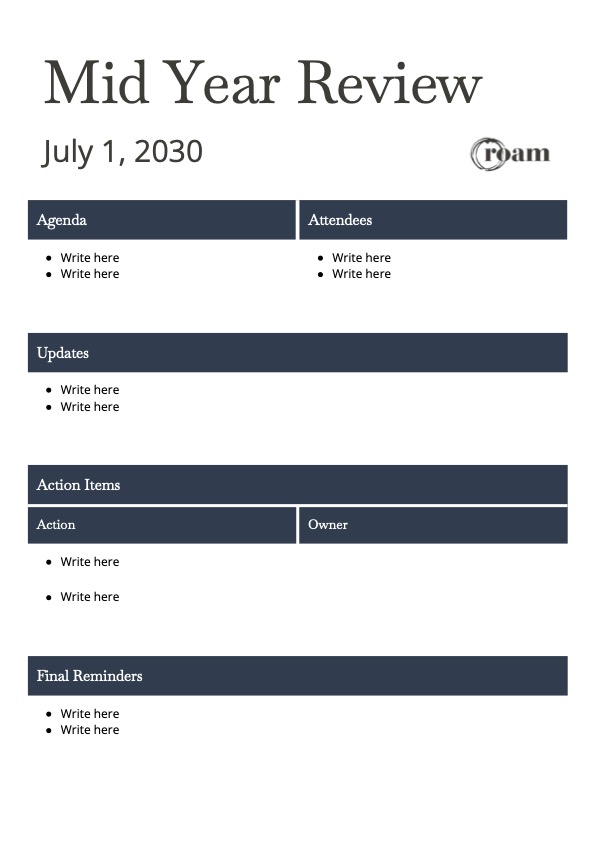Elevate Your Company’s Progress with a Mid-Year Review

A company-wide mid-year review is a pivotal process that allows organizations to assess their progress and realign their goals halfway through the year. It provides a structured opportunity to evaluate performance, set new objectives, and ensure everyone is on the same page.
So, what exactly is a company-wide mid-year review, and why is it important? This process involves evaluating the performance of all departments, identifying strengths and weaknesses, and making necessary adjustments to stay on track for year-end targets.
The benefits of conducting a mid-year review are clear. It offers a chance to measure progress, give constructive feedback, and implement timely course corrections. This midpoint review is an ideal time to reflect on achievements, address challenges, and prepare for a successful second half of the year.
Understanding the Company-Wide Mid-Year Review Process
A company-wide mid-year review is a structured evaluation conducted halfway through the year to assess the performance of various departments and teams within an organization. Unlike the annual review, which typically covers a broader scope and longer time frame, the mid-year review focuses on recent performance and immediate goals. This makes it a crucial tool for ensuring the company is on track to meet its year-end objectives.
The primary purpose of a company-wide mid-year review is to provide a clear snapshot of where the organization stands in relation to its goals. It helps identify what has been working well and what needs improvement. This process enables management to make informed decisions about resource allocation, strategy adjustments, and performance management.
Setting the right questions is vital to the success of the mid-year review. Open-ended questions, in particular, encourage detailed and thoughtful responses from employees, which can provide deeper insights into their performance and areas for growth. Questions might include:
- What achievements are you most proud of so far this year?
- What challenges have you faced, and how have you addressed them?
- How can we support you better in the coming months?
By focusing on open-ended questions, the review process becomes more than just a performance check; it becomes an opportunity for meaningful dialogue and feedback.
Best Practices for Conducting a Mid-Year Review
Preparing for a company-wide mid-year review requires careful planning and execution to ensure the process is effective and meaningful. Here are some best practices to follow:

1. Set a Clear Meeting Agenda
Prepare a detailed agenda for the mid-year review meeting to keep discussions focused and efficient. Outline the key topics to be covered, allocate specific time slots for each item, and distribute the agenda in advance so all participants come prepared. A well-structured agenda ensures that all important aspects are addressed and helps avoid unnecessary deviations.
2. Gather Comprehensive Data
- Collect performance data from all departments. This includes quantitative metrics, such as sales figures and productivity rates, as well as qualitative feedback from team members and managers. A thorough data collection process will provide a holistic view of the organization’s performance.
3. Encourage Honest Feedback
- Foster an environment where employees feel comfortable providing honest and constructive feedback. Anonymous surveys or one-on-one meetings can help gather candid insights. Constructive criticism is crucial for identifying weaknesses and areas for development.
4. Focus on Actionable Feedback
- Ensure that feedback provided during the review is actionable. Vague comments are less helpful than specific suggestions for improvement. For example, instead of saying “Improve communication,” offer concrete steps like “Hold weekly team meetings to discuss project updates.”
5. Involve All Levels of the Organization
- A company-wide review should include input from all levels, from entry-level employees to top management. This inclusive approach ensures that the review captures diverse perspectives and experiences, leading to more comprehensive insights.
6. Align Reviews with Company Goals
- Ensure that individual and departmental reviews are aligned with the overall company goals. This alignment helps reinforce the importance of each team’s contributions to the broader organizational objectives and keeps everyone moving in the same direction.
7. Plan for Follow-Up Actions
- A successful mid-year review doesn’t end with the evaluation. Develop a clear action plan based on the review findings. This plan should include specific tasks, responsible parties, and deadlines to address the identified issues and capitalize on strengths.
By following these best practices, organizations can conduct effective company-wide mid-year reviews that provide valuable insights, foster employee engagement, and drive continuous improvement.
Setting New Goals and Development Plans for Departments
A company-wide mid-year review is an ideal time to set new goals and create development plans for different departments. This process ensures that every part of the organization remains aligned with its overall objectives and continues to progress toward achieving them.
1. Evaluate Current Goals
- Start by reviewing the goals set at the beginning of the year. Assess which goals have been met, which are still in progress, and which need adjustment. This evaluation helps identify areas where departments are excelling or struggling.
2. Set SMART Goals
- Use the SMART criteria (Specific, Measurable, Achievable, Relevant, Time-bound) to set new goals for the second half of the year. This approach ensures that goals are clear and attainable, providing a roadmap for departments to follow. For example, a goal for the sales team might be to increase quarterly sales by 10%.
3. Develop Departmental Plans
- Each department should create a development plan that aligns with the new goals. These plans should include specific actions, resources needed, and timelines for achieving the objectives. A detailed plan helps teams stay focused and organized.
4. Foster Collaboration
- Encourage departments to collaborate on setting and achieving goals. Cross-departmental cooperation can lead to innovative solutions and a more cohesive approach to meeting company objectives. For instance, the marketing and sales teams might work together on a campaign to boost product awareness and drive sales.
5. Monitor and Adjust Goals
- Regularly track progress toward the new goals and be prepared to make adjustments as needed. This ongoing monitoring ensures that departments remain on the right path and can quickly address any issues that arise. Use performance metrics and regular check-ins to keep everyone accountable.
6. Support Professional Development
- Incorporate professional development into the goal-setting process. Offer opportunities for training, workshops, or online courses that help employees build the skills needed to achieve their goals. Investing in employee development benefits the individual and the organization as a whole.
7. Align with Company Strategy
- Ensure that the new goals and development plans are aligned with the company’s strategic direction. This alignment keeps all departments focused on contributing to the broader organizational objectives and helps maintain a unified effort.
By setting new goals and creating detailed development plans during the mid-year review, companies can ensure that all departments are working efficiently toward common objectives. This proactive approach helps maintain momentum, addresses challenges promptly, and prepares the organization for a successful second half of the year.
The Value of Professional Meeting Spaces for Company-Wide Mid-Year Reviews
Conducting a company-wide mid-year review in a professional meeting space can enhance the process. Spaces like Roam provide essential amenities and a focused environment, making reviews more efficient and productive.
Professional meeting spaces minimize distractions and boost productivity, fostering creativity and collaboration. Equipped with high-quality audio-visual equipment and reliable internet, our spaces ensure seamless presentations and video conferencing.
Additionally, our customizable setups cater to various needs, whether its for large gatherings or small group discussions. Roam’s flexible booking options and locations in Atlanta and Dallas also add convenience, improving attendance and participation.
Using a professional meeting space shows a commitment to valuing the review process and the people involved. It creates a positive atmosphere that enhances the overall experience, making employees feel more valued and engaged.
By leveraging professional meeting spaces, like those provided by Roam, organizations can conduct more efficient, focused, and productive mid-year reviews, leading to better outcomes and stronger alignment with company goals.
